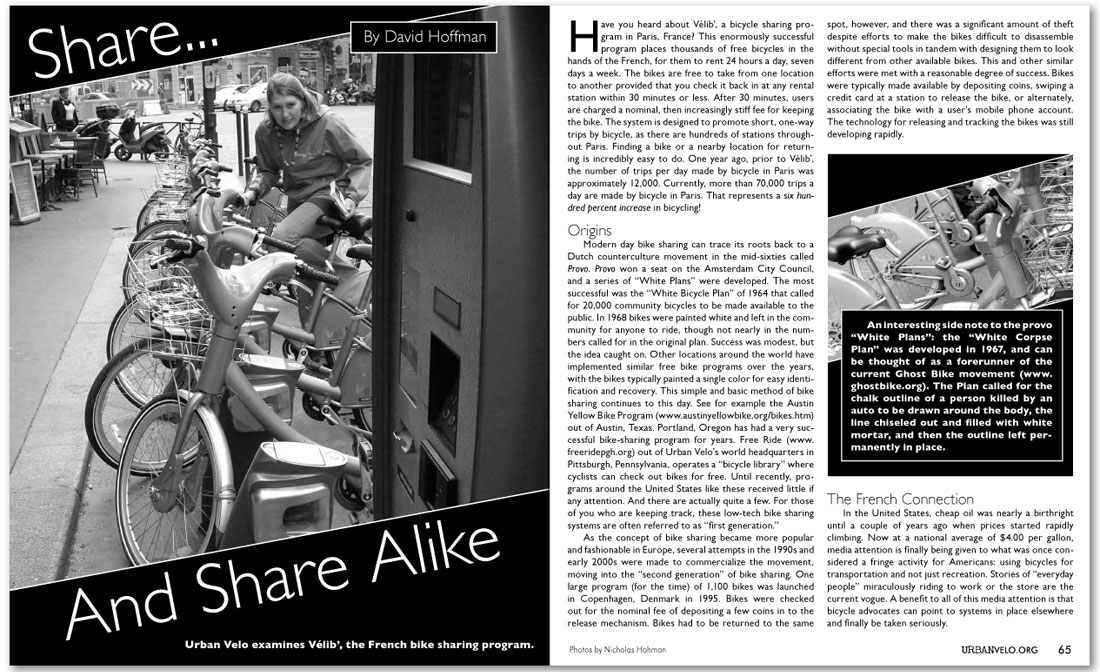Have you heard about Vélib’, a bicycle sharing program in Paris, France? This enormously successful program places thousands of free bicycles in the hands of the French, for them to rent 24 hours a day, seven days a week. The bikes are free to take from one location to another provided that you check it back in at any rental station within 30 minutes or less. After 30 minutes, users are charged a nominal, then increasingly stiff fee for keeping the bike. The system is designed to promote short, one-way trips by bicycle, as there are hundreds of stations throughout Paris. Finding a bike or a nearby location for returning is incredibly easy to do. One year ago, prior to Vélib’, the number of trips per day made by bicycle in Paris was approximately 12,000. Currently, more than 70,000 trips a day are made by bicycle in Paris. That represents a six hundred percent increase in bicycling!
Origins
Modern day bike sharing can trace its roots back to a Dutch counterculture movement in the mid-sixties called Provo. Provo won a seat on the Amsterdam City Council, and a series of “White Plans” were developed. The most successful was the “White Bicycle Plan” of 1964 that called for 20,000 community bicycles to be made available to the public. In 1968 bikes were painted white and left in the community for anyone to ride, though not nearly in the numbers called for in the original plan. Success was modest, but the idea caught on. Other locations around the world have implemented similar free bike programs over the years, with the bikes typically painted a single color for easy identification and recovery. This simple and basic method of bike sharing continues to this day. See for example the Austin Yellow Bike Program (www.austinyellowbike.org/bikes.htm) out of Austin, Texas. Portland, Oregon has had a very successful bike-sharing program for years. Free Ride (www.freeridepgh.org) out of Urban Velo’s world headquarters in Pittsburgh, Pennsylvania, operates a “bicycle library” where cyclists can check out bikes for free. Until recently, programs around the United States like these received little if any attention. And there are actually quite a few. For those of you who are keeping track, these low-tech bike sharing systems are often referred to as “first generation.”
As the concept of bike sharing became more popular and fashionable in Europe, several attempts in the 1990s and early 2000s were made to commercialize the movement, moving into the “second generation” of bike sharing. One large program (for the time) of 1,100 bikes was launched in Copenhagen, Denmark in 1995. Bikes were checked out for the nominal fee of depositing a few coins in to the release mechanism. Bikes had to be returned to the same spot, however, and there was a significant amount of theft despite efforts to make the bikes difficult to disassemble without special tools in tandem with designing them to look different from other available bikes. This and other similar efforts were met with a reasonable degree of success. Bikes were typically made available by depositing coins, swiping a credit card at a station to release the bike, or alternately, associating the bike with a user’s mobile phone account. The technology for releasing and tracking the bikes was still developing rapidly.
The French Connection
In the United States, cheap oil was nearly a birthright until a couple of years ago when prices started rapidly climbing. Now at a national average of $4.00 per gallon, media attention is finally being given to what was once considered a fringe activity for Americans: using bicycles for transportation and not just recreation. Stories of “everyday people” miraculously riding to work or the store are the current vogue. A benefit to all of this media attention is that bicycle advocates can point to systems in place elsewhere and finally be taken seriously.
